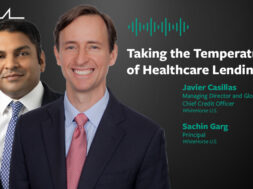Health Care’s Retail Revolution
The patient experience is shaping the way care is delivered, and it’s prompting health care providers to rethink their offerings and how they measure business performance.

This story originally appeared in the Winter 2021 print edition of Middle Market Growth magazine. Read the full issue in the archive.
Consumer expectations for convenience and personalized service have shaped many industries. But even a decade ago, health care wasn’t one of them.
“The notion of a consumer experience in health care—that seemed like such a foreign concept years ago,” says Barry Uphoff, managing partner and founder of Martis Capital, a private equity firm that invests in middle-market health care companies.
That’s changed. Today, the patient experience is shaping the way care is delivered, and it’s prompting health care providers to rethink their offerings and how they measure business performance.
Matt Wolf, director and health care senior analyst at RSM US LLP, sees two main drivers behind this “consumerization” trend in health care: rising costs and lack of convenience. Patients are spending more money than ever on premiums, deductibles and co-pays. When they don’t see improved services along with those increased costs, they’re disappointed. They’ve come to expect convenience in other areas of their lives, such as banking and entertainment. Why not their doctor’s office?
“You can do anything from anywhere, in a way that is customized and delivered on demand to you, except for the most important part of your life, which is health care,” Wolf says.
Regulations within HIPAA, the law designed to protect patients’ privacy, have stifled health care’s technology adoption, something Wolf experienced firsthand last year. After his toddler dragged his eyeglasses across concrete, Wolf needed a copy of his prescription to order a new pair and was told that it had to be sent by fax.
Wolf expects innovators will find ways to provide more convenient, customized service. “Obviously, it needs to be done in a way that’s safe and effective and clinically relevant, but outside the traditional regulatory framework,” he says. “There’s an opportunity for outside disruption. We haven’t seen it yet, but it’s going to happen.”
One area he’s watching is mental health. “It is still sort of new territory. Obviously, it’s still highly regulated, but the clay is a little easier to shape, in terms of innovative digital delivery models,” Wolf says. He also notes that the Affordable Care Act expanded coverage for mental and behavioral health. “We’ve seen more acquisition and private equity investment focused on that … because for many people, they are now covered for the first time.”

Expanded coverage isn’t the only force boosting interest in behavioral health services. More recently, the COVID-19 outbreak prompted a spike in mental health treatment. MindPath Care Centers, an outpatient mental health care practice, hired 47 clinicians between April and December last year in an effort to meet demand. “Pre-pandemic, we prided ourselves on getting patients in within 14 days,” says MindPath CEO Jeff Williams. “Demand is so blistering, now it’s 10 weeks.” In November 2019, MindPath clinicians handled about 3,500 patient visits a week—a year later, that number had surged to about 6,000.
You can do anything from anywhere, in a way that is customized and delivered on demand to you, except for the most important part of your life, which is health care.
Matt Wolf
Director and Health Care Senior Analyst, RSM US LLP
Another dramatic shift for MindPath has been the increased use of telemedicine. The company had already implemented a telemedicine platform three years earlier, but as of the first week of March 2020, only about 11% of visits took place remotely. By the end of the year, about 90% of MindPath’s therapy visits and 76% of medication management took place online.
This reflects a nationwide health care trend in 2020. When the Centers for Disease Control and Prevention analyzed data from four of the largest U.S. telehealth providers that offer services in all states, it found that the number of telehealth visits increased by 50% during the first quarter of 2020, compared with the same period in 2019.
Although Williams expects telemedicine visits will decline when the pandemic ends, he estimates telemedicine could still account for about 35% of visits, or triple the volume experienced by MindPath before the COVID-19 outbreak.
The company’s increased use of telemedicine has required some operational fine-tuning, including having staff to hop on the phone with providers and patients when technology malfunctions or isn’t intuitive. “Normally, you’ve got patients in the waiting room … Now you’ve got patients on the phone saying, ‘I can’t find the app. I can’t get logged on. I don’t know how to find where I’m supposed to go,’” Williams says. “I mean, it’s like it’s endless. And so there’s a lot of handholding that is happening at that level.”

MindPath tries to create positive experiences for consumers, beginning with the call center for new patient intake. “These people answering the phones are trained to realize that they’re not just an order-taker, they’re not just booking appointments,” Williams says. “They’re actually starting the therapy for the patient. Patients finally took that first step and realize they needed help. And the first hand that reaches out with this person on the other end of the phone, that makes them feel like they’re already on their way.”
Normally, you’ve got patients in the waiting room … now you’ve got patients on the phone saying, ‘I can’t find the app. I can’t get logged on. I don’t know how to find where I’m supposed to go.’
Jeff Williams
CEO, MindPath Care
The company measures patient satisfaction with every interaction, according to Williams. “We’re working every day to put things in place and be even more patient-centric,” he says.
That includes hiring a new position, a patient experience manager, at the start of 2021. “The intent for that role is to be in charge of the patient experience,” he says. “And that means from appointment to care, to billing and rescheduling—everything that’s happening along that cycle.”
MindPath has always been diligent about following up with customer complaints, something the new staff member will take even further. They will be tasked with finding ways to address the causes of complaints, which typically don’t involve the care itself.
“The appointment is the easy part, because the providers are good,” Williams says. “It’s everything else. How easy is it? How easy is it for [patients] to do business with us? That’s what it comes down to. And is it a good experience?”
Millennial Model
Health care executives aren’t the only leaders focused on the patient experience. Investors also are watching the shift toward patient-centric care as they make investment decisions and work with portfolio companies.
At its annual meeting in late 2019, private equity firm Martis Capital emphasized consumerization as the driving force in health care. “We felt that we were starting to see, fundamentally, the consumer starting to act like a consumer,” says Uphoff. “And we highlighted how much of that consumerization was being driven by millennials starting to make decisions in health care, not only for themselves, but also for their parents.”
When considering potential investments, Martis likes companies that have a strong consumer focus, but it’s not a requirement. “If a company does not have that, we’re not afraid to invest and view that as an opportunity for improvement,” Uphoff says.
Several of the firm’s portfolio companies use net promoter scores, or NPS, which measure the likelihood that a consumer will recommend a product or service to someone else. Uphoff says Martis began implementing NPS about five years ago, as part of a commitment to supporting its companies’ consumerization efforts with data collection and analytics, along with other technology resources.
A decade ago, Uphoff wasn’t even aware of NPS; even five years ago, these metrics were still associated with tech giants like Amazon, he says. “But now, we look at those numbers across the board and see how they’re doing, and invest money to make sure that we’re improving those numbers throughout our ownership period.”
Those ratings matter, as brand perception gains relevance. When more health care providers adopt virtual care models, it changes how those businesses compete.

“It used to be that brand name wasn’t terribly important for health care providers,” says RSM’s Wolf. What mattered was having facilities in convenient locations, and a good referral network with other providers. “But as care becomes virtually scalable and digitized, brand might become more important,” he says. “If you can use any provider around the world on your phone, will you want to use the one down the street?”
Shining Light on Improvements
Sun Capital Partners has invested in several health care-related companies, and helps them develop a consumer-focused approach that encompasses more than clinical care.
When the private equity firm looks for investments, it focuses on providers with specialized clinical capabilities, says Stephen Cella, a principal at the firm. “That’s the most important part and most difficult function of a multi-site health care business,” he says.
We felt that we were starting to see, fundamentally, the consumer starting to act like a consumer.
Barry Uphoff
Managing Partner and Founder, Martis Capital
After Sun Capital finds a company that knows how to recruit and retain the best doctors, it focuses on implementing consumer best practices. That can include working with businesses to build digital marketing expertise, or enhancing call center operations so they provide a more informational and consultative function, instead of just booking appointments.
After investing in dental implant provider ClearChoice (which Sun Capital sold in November), the firm helped guide the company’s approach to scheduling. It began reserving appointments in blocks, similar to the way that airlines operate, says Cella. “[Airlines] are able to estimate who is most likely and least likely to show up for a flight, and so they can often sell more than 100% of tickets to the plane. We installed a very similar model within ClearChoice.”
Sun Capital also worked with ClearChoice’s team to test communication effectiveness with patients to determine whether a follow-up call or an email with an explanatory video would work best to address questions and concerns. The company also considered which points in the patient life cycle benefited most from certain types of communication. Says Cella: “We were able to develop a much more comprehensive, longer-term dialogue with the patient, where they were now coming in, feeling educated, confident, excited about the procedure.” The result, he adds, was a higher volume of completed procedures, greater patient satisfaction, and less anxiety about those procedures.
Sun Capital also helps its portfolio companies use analytics and key performance indicators, or KPIs, to improve the ways they serve consumers. “We want to make sure they’re actually tracking and measuring things that reflect on the patient experience,” Cella says. “How often are your patients coming back within a year? What’s your recurring patient base? Are there certain offices or doctors or patient types that are performing lower on these metrics that we can have insights into?”
The goal is to encourage management teams to expand their focus beyond measuring clinical quality and outcomes, and also consider patient feedback and the overall patient experience, he says.
The Data Dilemma
Not all health care businesses have the systems to collect and analyze data, which poses a dilemma for investors.
“In private equity, there’s a lot of frustration … they’re looking to make a decision and the data’s not there because consumerization has not been a priority for that practice,” says Jay Stine, a partner at accounting firm DHG.
In private equity, there’s a lot of frustration … they’re looking to make a decision and the data’s not there because consumerization has not been a priority for that practice.
Jay Stine
Partner, DHG LLP
Small practices don’t have the budget or resources required even to begin analyzing their customer base and to determine what improvements should be made, notes Stine, who leads the health care-focused team within DHG’s Transaction Advisory Practice.
“Typically, the owner is the leading provider. And so he’s seeing patients Monday through Friday, 8 a.m. to 5 p.m. … they just don’t have the time. Why would I invest dollars in something that I don’t even have time to analyze?”
That can complicate M&A decisions. During due diligence, relevant data is sometimes missing: the number of patient visits for a specific provider, for example, or the number of visits by service type. “Stuff like that, where we’re trying to go one layer deeper and it’s sometimes just not there,” Stine says.
When a practice lacks analytics to help explain why certain numbers have dropped, that can be a red flag for private equity. Says Stine, “How do we make sure that it’s not going to continue to go down? As we’re looking to try to put a valuation on this … how do you get comfortable with those trends to make an investment?”
Yet despite these challenges, private equity buy-and-build strategies are expected to continue. “In talking with [our] private equity clients, there’s an even stronger thought process around the roll-up. I think it’s only getting bigger,” Stine says.
Technology’s Limits
Although technology remains vital for continued consumerization, Wolf cautions against overstating its place in health care’s future.
“There will always be a role for humans in clinical care,” he says. “Even if we get to the point where I could put my thumb on my iPhone and it could tell me whether or not I had one of 300 different types of cancer, I still want that oncologist who understands what went into the diagnosis, who understands what it means for me, and puts her hand on my shoulder and explains the process. And provides the sort of guidance, and that human touch that only a board-certified oncologist could do.”
Consumerization isn’t about replacing clinicians, Wolf stresses. “It’s about augmenting them, so they can focus on the most value-added part of their role, which is providing care and helping people get better or stay healthy.”
The patient experience was a growing priority for health care providers before COVID-19. “Prior to the pandemic, we would talk to clients or anyone who would listen about the direction where health care was going. This idea of a highly customized, on-demand health care experience,” Wolf recalls. “We would say, ‘This is the point on the horizon where you want to start steering the ship, but it’s a ways out.’”
The increase in virtual visits and rising use of technology over the last 12 months suggest that ship has sailed. “I think in many respects, the pandemic accelerated that by five or maybe 10 years,” he says.
S.A. Swanson is a contributing editor at Middle Market Growth.


